matlab导出数据(fprintf,dlmwrite,xlswrite)
实验八MATLAB文件操作与数据导入导出

实验八 Matlab 文件操作与数据接口一、实验目的1、熟练掌握工作区变量的文件操作;2、熟练掌握文本文件的读写操作;3、熟练掌握格式化文本文件的输入输出语句的执行4、了解二进制文件、Mat文件的读写操作二、实验仪器与软件1. PC计算机2. Matlab软件三、实验原理1. 二进制文件与文本文件的区别:将文件看作是由一个一个字节(byte) 组成的,那么文本文件中的每个字节的最高位都是0,也就是说文本文件使用了一个字节中的七位来表示所有的信息,而二进制文件则是将字节中的所有位都用上了。
这就是两者的区别;接着,第二个问题就是文件按照文本方式或者二进制方式打开,两者会有什么不同呢?其实不管是二进制文件也好,还是文本文件也好,都是一连串的0和1,但是打开方式不同,对于这些0和1的处理也就不同。
如果按照文本方式打开,在打开的时候会进行translate,将每个字节转换成ASCII 码,而以按照二进制方式打开的话,则不会进行任何的translate;最后就是文本文件和二进制文件在编辑的时候,使用的方式也是不同的。
譬如,你在记事本中进行文本编辑的时候,你进行编辑的最小单位是字节(byte);而对二进制文件进行编辑的话,最小单位则是位(bi t),当然我们都不会直接通过手工的方式对二进制文件进行编辑了。
从文件编码的方式来看,文件可分为ASCII码文件和二进制码文件两种:ASCII文件也称为文本文件,这种文件在磁盘中存放时每个字符对应一个字节,用于存放对应的ASCII码。
例如,数5678的存储形式为:ASCII码:00110101 00110110 00110111 00111000↓↓↓↓十进制码:5678共占用4个字节。
ASCII码文件可在屏幕上按字符显示,例如源程序文件就是A SCII文件,用DOS命令TYPE可显示文件的内容。
由于是按字符显示,因此能读懂文件内容。
二进制文件是按二进制的编码方式来存放文件的。
MATLAB读写函数一些使用说明
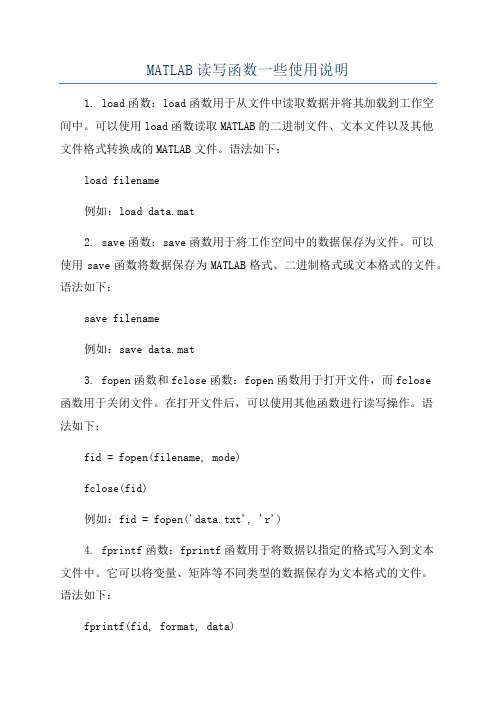
MATLAB读写函数一些使用说明1. load函数:load函数用于从文件中读取数据并将其加载到工作空间中。
可以使用load函数读取MATLAB的二进制文件、文本文件以及其他文件格式转换成的MATLAB文件。
语法如下:load filename例如:load data.mat2. save函数:save函数用于将工作空间中的数据保存为文件。
可以使用save函数将数据保存为MATLAB格式、二进制格式或文本格式的文件。
语法如下:save filename例如:save data.mat3. fopen函数和fclose函数:fopen函数用于打开文件,而fclose函数用于关闭文件。
在打开文件后,可以使用其他函数进行读写操作。
语法如下:fid = fopen(filename, mode)fclose(fid)例如:fid = fopen('data.txt', 'r')4. fprintf函数:fprintf函数用于将数据以指定的格式写入到文本文件中。
它可以将变量、矩阵等不同类型的数据保存为文本格式的文件。
语法如下:fprintf(fid, format, data)例如:fprintf(fid, '%d %f', A)5. fscanf函数:fscanf函数用于从文本文件中按指定的格式读取数据。
可以使用fscanf函数读取数字、字符串、矩阵等类型的数据。
语法如下:data = fscanf(fid, format, size)例如:data = fscanf(fid, '%d %f', [2, 3])6. xlsread函数和xlswrite函数:xlsread函数用于从Excel文件中读取数据,而xlswrite函数用于将数据写入Excel文件。
这两个函数可以方便地读写Excel文件中的数据。
语法如下:data = xlsread(filename, sheet, range)xlswrite(filename, data, sheet, range)例如:data = xlsread('data.xlsx', 'Sheet1', 'A1:C3')7. imread函数和imwrite函数:imread函数用于从图像文件中读取图像数据,而imwrite函数用于将图像数据保存为图像文件。
matlab导出数据(fprintf,dlmwrite,xlswrite)

matlab导出数据(fprintf,dlmwrite,xlswrite)1.用fprintf 函数写数据到txt,xlsExample:x = 0:.1:1;y = [x; exp(x)];fid = fopen('exp.txt', 'w');fprintf(fid, '%6.2f %12.8f\n', y);fclose(fid)tip:执行上述代码执行,肯定不会换行的,换行的问题试一下下面的代码x = 0:.1:1;y = [x; exp(x)];fid = fopen('exp.txt', 'wt');fprintf(fid, '%6.2f %12.8f\n', y);fclose(fid);这次就没有问题了,我们要注意fopne的参数wt 而不是 w,这是matlab的在线帮助的东东fid = fopen(filename, permission_tmode) on Windows systems, opens the file in textmode instead of binary mode (the default). The permission_tmode argument consistsof any of the specifiers shown in the Permission Specifiers table above, followedby the letter t, for example 'rt' or 'wt+. On UNIX®systems, text and binary modeare the same. (UNIX is a registered trademark of TheOpen Group in the United States and other countries).就是有两种读取模式binary or text. When choosing the binary model,No characters aregiven special treatment. 所以我们选择要注明text模式。
matlab建模数据的导入与导出
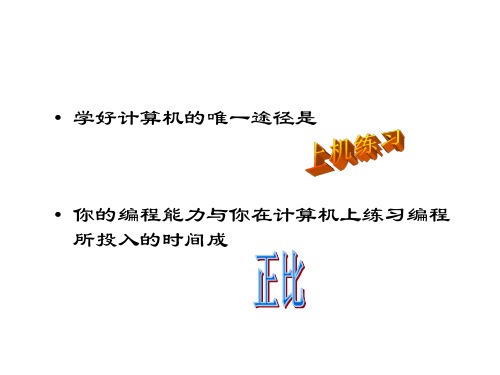
五Hale Waihona Puke 数据导出• save filename varlist 文件格式为mat,只能用load filename 导入 • dlmwrite(„filename‟,m):writes matrix m into filename using the “,” as the delimiter. 可用 dlmread(„filename‟) 或csvread(„filename‟) 读取 • csvwrite(filename,m) writes matrix m into filename as comma separated values. 结果与dlmwrite相同
七、图形的复制与保存
• 图形窗口->edit->copy figure-> word文档->粘贴
努力不一定成功 放弃一定是失败
处理函数 数值文件(一般分隔):dlmread, dlmwrite ,load ,save 文本文件(逗号分隔) :textread, csvread, csvwrite 二进制文件:fopen, fread, fwrite, fclose 格式化的文本输入/输出:fscanf, fprintf 图像数据的读写:imread, imwrite,imshow
其中names、 types 、 answer 均为cell数据类型。如 names{1} 对应‘Sally‟ answer{2}对应‘No‟。 x, y 均为double型 数组
• • • •
2009年全国数模赛B题数据的 导入
题目: 第一步:现将数据复制到记事本中: 第二步:编写程序,读取数据 第三部:数据处理与分析
• 学好计算机的唯一途径是
• 你的编程能力与你在计算机上练习编程 所投入的时间成
matlab中的数据导入和导出

matlab中的数据导入和导出Matlab提供了从磁盘文件或剪贴簿转载数据至工作区(数据导入)和将工作区变量存入磁盘文件(数据导出)的多种途径。
最简单的办法是使用界面导入向导,打开文件菜单中的导入数据而后按提示操作。
Matlab支持的主要数据文件类型和对应函数如下:导入文本文件文本文件需要具备统一的行列模式,使用分隔符作为数据项间隔,这些分隔符包括空格、逗号、tab、分号或其它。
数据文件可能附带标题行和行列头标签。
数值数据对于数值数据可以直接使用load函数装载,例如my_data.txt中数据如下:1 2 3 4 56 7 8 9 10命令A = load('my_data.txt')装载该文本文件数据。
如果数值数据使用其它分隔符,可以使用dlmread读入,假设my_data.txt中数据如下:7.2;8.5;6.2;6.65.4;9.2;8.1;7.2命令A = dlmread('my_data.txt', ';')读入该数据。
包含行列标签的数值数据例如:Grade1 Grade2 Grade378.8 55.9 45.999.5 66.8 78.089.5 77.0 56.7fid = fopen('grades.dat', 'r');grades = textscan(fid, '%f %f %f', 3, 'headerlines', 1);fclose(fid);包含字符和数值的混合数据使用textread函数读入。
导出文本文件save函数A = [ 1 2 3 4 ; 5 6 7 8 ];save my_data.out A –ASCIIdlmwrite函数dlmwrite('my_data.out',A, ';')MS-Excel电子表格文件xlsinfo获得文件信息使用命令[type, sheets] = xlsfinfo(filename)返回文件类型type 和工作表信息。
matlab中将数据输出保存为txt格式文件的方法
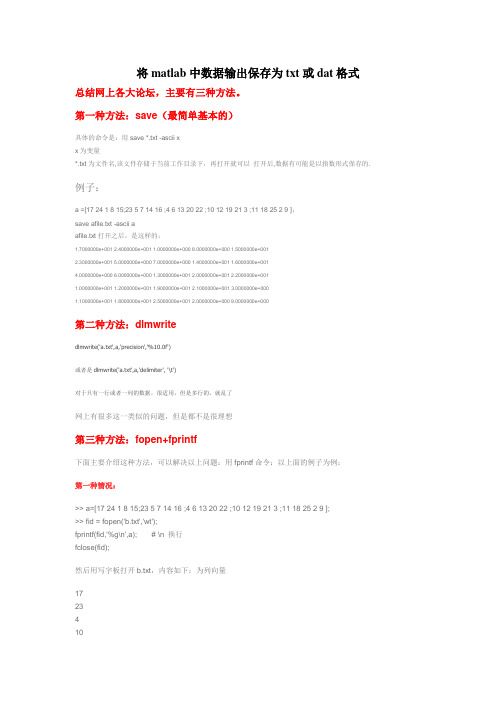
将matlab中数据输出保存为txt或dat格式总结网上各大论坛,主要有三种方法。
第一种方法:save(最简单基本的)具体的命令是:用save *.txt -ascii xx为变量*.txt为文件名,该文件存储于当前工作目录下,再打开就可以打开后,数据有可能是以指数形式保存的.例子:a =[17 24 1 8 15;23 5 7 14 16 ;4 6 13 20 22 ;10 12 19 21 3 ;11 18 25 2 9 ];save afile.txt -ascii aafile.txt打开之后,是这样的:1.7000000e+0012.4000000e+001 1.0000000e+000 8.0000000e+000 1.5000000e+0012.3000000e+001 5.0000000e+000 7.0000000e+000 1.4000000e+001 1.6000000e+0014.0000000e+000 6.0000000e+000 1.3000000e+001 2.0000000e+001 2.2000000e+0011.0000000e+001 1.2000000e+001 1.9000000e+0012.1000000e+0013.0000000e+0001.1000000e+001 1.8000000e+0012.5000000e+001 2.0000000e+000 9.0000000e+000第二种方法:dlmwritedlmwrite('a.txt',a,'precision','%10.0f')或者是dlmwrite('a.txt',a,'delimiter', '\t')对于只有一行或者一列的数据,很适用,但是多行的,就乱了网上有很多这一类似的问题,但是都不是很理想第三种方法:fopen+fprintf下面主要介绍这种方法,可以解决以上问题:用fprintf命令:以上面的例子为例:第一种情况:>> a=[17 24 1 8 15;23 5 7 14 16 ;4 6 13 20 22 ;10 12 19 21 3 ;11 18 25 2 9 ];>> fid = fopen('b.txt','wt');fprintf(fid,'%g\n',a); # \n 换行fclose(fid);然后用写字板打开b.txt,内容如下:为列向量17234101124561218171319258142021215162239第二种情况:对上面的命令做一下改动:# \n 换行改为\t,table键>> fid = fopen('b.txt','w');fprintf(fid,'%g\t',a);fclose(fid);然后用写字板打开b.txt,内容如下:为行向量:17 23 4 10 11 24 5 6 12 18 1 7 13 19 25 8 14 20 21 2 15 16 22 3 9第三种情况:综合上面的两个结果,我们编写以下命令:<A style="key: fid=fopen('b.txt','wt');%写入文件路径[m,n]=size(a);for i=1:1:mfor j=1:1:nif j==nfprintf(fid,'%g\n',a(i,j));elsefprintf(fid,'%g\t',a(i,j));endendendfclose(fid);然后用写字板打开b.txt,内容如下:矩阵17 24 1 8 1523 5 7 14 164 6 13 20 2210 12 19 21 311 18 25 2 9说明:以上操作都是在当前的工作目录下完成!下面给出最一般的模型,大家可以试着自己操作,如果需要dat格式,直接把txt换为dat就可以fid=fopen('C:\Documents and Settings\cleantotal.ped','wt');%写入文件路径matrix=input_mattrix %input_matrix为待输出矩阵[m,n]=size(matrix);for i=1:1:mfor j=1:1:nif j==nfprintf(fid,'%g\n',matrix(i,j));elsefprintf(fid,'%g\t',matrix(i,j));endendendfclose(fid);×××××××××××××××××××××××××××××××××××××××××××××××××××××××××下面附了具体的matlab的fopen和fprintf函数具体解释,当然help一下是可以知道的,只是为了方便大家matlab中fopen函数在指定文件打开的实例如下:*1)“fopen”打开文件,赋予文件代号。
Matlab输出内容到Excel的方法(WPS可用)
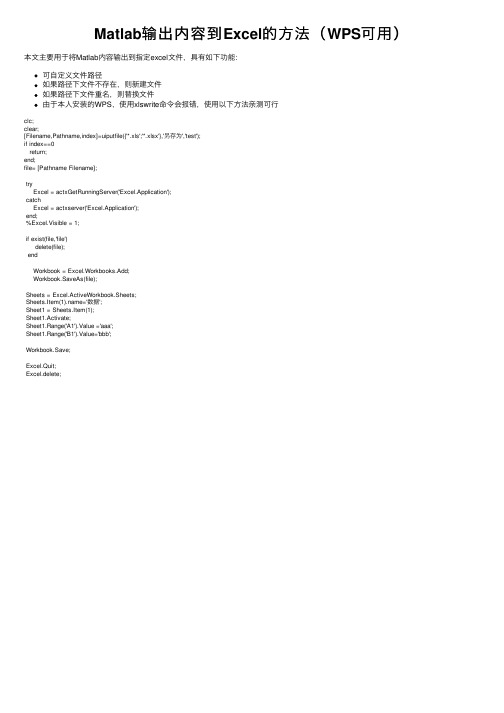
return; end; file= [Pathname Filename];
try Excel = actxGetRunningServer('Excel.Application');
Sheets = Excel.ActiveWorkbook.Sheets; Sheets.Item(1).name='数据'; Sheet1 = Sheets.Item(1); Sheet1.Activate; Sheet1.Range('A1').Value ='aaa'; Sheet1.Range('B1').Value='bbb';
catch Excel = actxserver('Excel.Application');
end; %Excel.Visible = 1;
if exist(file,'file') delete(file);
end
Workbook = Excel.Workbooks.Add; Workbook.SaveAs(file);
登录后才能查看或发表评论立即登录或者逛逛博客园首页
Matlab输出内容到 Excel的方法( WPS可用)
本文主要用于将Matlab内容输出到指定excel文件,具有如下功能:
可自定义文件路径 如果路径下文件不存在,则新建文件 如果路径下文件重名,则替换文件 由于本人安装的WPS,使用xlswrite命令会报错,使用以下方法亲测可行
matlab中将数据输出保存为txt格式文件的方法 (1)
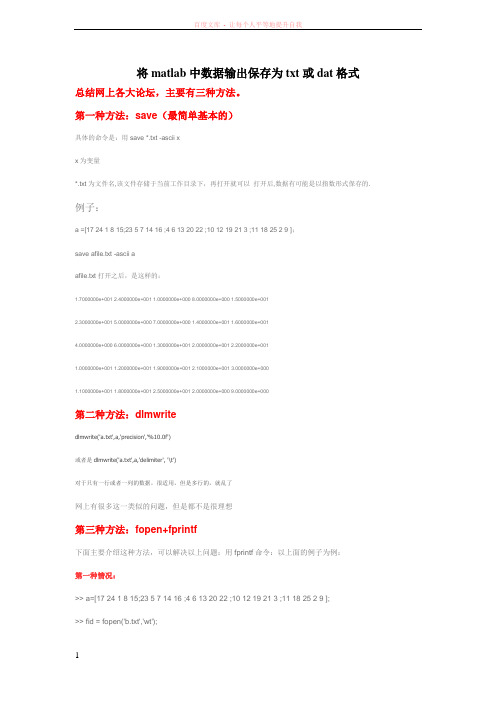
将matlab中数据输出保存为txt或dat格式总结网上各大论坛,主要有三种方法。
第一种方法:save(最简单基本的)具体的命令是:用save *.txt -ascii xx为变量*.txt为文件名,该文件存储于当前工作目录下,再打开就可以打开后,数据有可能是以指数形式保存的.例子:a =[17 24 1 8 15;23 5 7 14 16 ;4 6 13 20 22 ;10 12 19 21 3 ;11 18 25 2 9 ];save afile.txt -ascii aafile.txt打开之后,是这样的:1.7000000e+0012.4000000e+001 1.0000000e+000 8.0000000e+000 1.5000000e+0012.3000000e+001 5.0000000e+000 7.0000000e+000 1.4000000e+001 1.6000000e+0014.0000000e+000 6.0000000e+000 1.3000000e+001 2.0000000e+001 2.2000000e+0011.0000000e+001 1.2000000e+001 1.9000000e+0012.1000000e+0013.0000000e+0001.1000000e+001 1.8000000e+0012.5000000e+001 2.0000000e+000 9.0000000e+000第二种方法:dlmwritedlmwrite('a.txt',a,'precision','%10.0f')或者是dlmwrite('a.txt',a,'delimiter', '\t')对于只有一行或者一列的数据,很适用,但是多行的,就乱了网上有很多这一类似的问题,但是都不是很理想第三种方法:fopen+fprintf下面主要介绍这种方法,可以解决以上问题:用fprintf命令:以上面的例子为例:第一种情况:>> a=[17 24 1 8 15;23 5 7 14 16 ;4 6 13 20 22 ;10 12 19 21 3 ;11 18 25 2 9 ];>> fid = fopen('b.txt','wt');fprintf(fid,'%g\n',a); # \n 换行fclose(fid);然后用写字板打开b.txt,内容如下:为列向量17234101124561218171319258142021215162239第二种情况:对上面的命令做一下改动:# \n 换行改为\t,table键>> fid = fopen('b.txt','w');fprintf(fid,'%g\t',a);fclose(fid);然后用写字板打开b.txt,内容如下:为行向量:17 23 4 10 11 24 5 6 12 18 1 7 13 19 25 8 14 20 21 2 15 16 22 3 9 第三种情况:综合上面的两个结果,我们编写以下命令:<A style="key: ,'wt');%写入文件路径[m,n]=size(a);for i=1:1:mfor j=1:1:nif j==nfprintf(fid,'%g\n',a(i,j));elsefprintf(fid,'%g\t',a(i,j));endendendfclose(fid);然后用写字板打开b.txt,内容如下:矩阵17 24 1 8 1523 5 7 14 164 6 13 20 2210 12 19 21 311 18 25 2 9说明:以上操作都是在当前的工作目录下完成!下面给出最一般的模型,大家可以试着自己操作,如果需要dat格式,直接把txt换为dat就可以fid=fopen('C:\Documents and Settings\cleantotal.ped','wt');%写入文件路径matrix=input_mattrix %input_matrix为待输出矩阵[m,n]=size(matrix);for i=1:1:mfor j=1:1:nif j==nfprintf(fid,'%g\n',matrix(i,j));elsefprintf(fid,'%g\t',matrix(i,j));endendendfclose(fid);×××××××××××××××××××××××××××××××××××××××××××××××××××××××××下面附了具体的matlab的fopen和fprintf函数具体解释,当然help一下是可以知道的,只是为了方便大家matlab中fopen函数在指定文件打开的实例如下:*1)“fopen”打开文件,赋予文件代号。
matlab文件数据读写

matlab文件数据读写MATLAB中文件输入及输出指令一、基本文件输入输出File import/export functions.dlmread- Read ASCII delimited file.dlmwrite- Write ASCII delimited file.importdata - Load data from a file into MATLAB.daqread- Read Data Acquisition Toolbox (.daq) data file.matfinfo- Text description of MAT-file contents.xlsread - Get data and text from a spreadsheet in an Excel workbook.xlswrite- Stores numeric array or cell array in Excel workbook.xlsfinfo - Determine if file contains Microsoft Excel spreadsheet.Formatted file I/O.fgetl- Read line from file, discard newline character.fgets - Read line from file, keep newline character.fprintf - Write formatted data to file.fscanf - Read formatted data from file.textscan - Read formatted data from text file.textread - Read formatted data from text file.File opening and closing.fopen - Open file.fclose - Close file.Binary file I/O.fread - Read binary data from file.fwrite - Write binary data to file.File positioning.feof - Test for end-of-file.ferror - Inquire file error status.frewind - Rewind file.fseek - Set file position indicator.ftell - Get file position indicator.matlab 读取文件各种方法本技术支持指南主要处理:ASCII, binary, and MAT files.要得到MA TLAB中可用来读写各种文件格式的完全函数列表,可以键入以下命令:help iofunMATLAB中有两种文件I/O程序:high level and low level.High level routines:包括现成的函数,可以用来读写特殊格式的数据,并且只需要少量的编程。
Matlab中的文件操作与数据导入导出方法
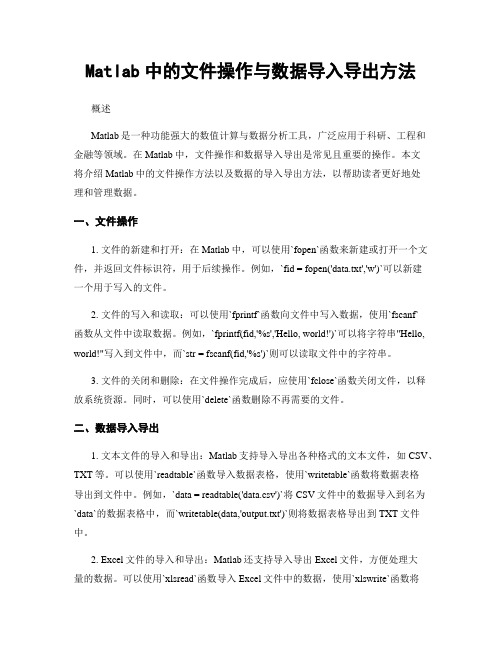
Matlab中的文件操作与数据导入导出方法概述Matlab是一种功能强大的数值计算与数据分析工具,广泛应用于科研、工程和金融等领域。
在Matlab中,文件操作和数据导入导出是常见且重要的操作。
本文将介绍Matlab中的文件操作方法以及数据的导入导出方法,以帮助读者更好地处理和管理数据。
一、文件操作1. 文件的新建和打开:在Matlab中,可以使用`fopen`函数来新建或打开一个文件,并返回文件标识符,用于后续操作。
例如,`fid = fopen('data.txt','w')`可以新建一个用于写入的文件。
2. 文件的写入和读取:可以使用`fprintf`函数向文件中写入数据,使用`fscanf`函数从文件中读取数据。
例如,`fprintf(fid,'%s','Hello, world!')`可以将字符串"Hello, world!"写入到文件中,而`str = fscanf(fid,'%s')`则可以读取文件中的字符串。
3. 文件的关闭和删除:在文件操作完成后,应使用`fclose`函数关闭文件,以释放系统资源。
同时,可以使用`delete`函数删除不再需要的文件。
二、数据导入导出1. 文本文件的导入和导出:Matlab支持导入导出各种格式的文本文件,如CSV、TXT等。
可以使用`readtable`函数导入数据表格,使用`writetable`函数将数据表格导出到文件中。
例如,`data = readtable('data.csv')`将CSV文件中的数据导入到名为`data`的数据表格中,而`writetable(data,'output.txt')`则将数据表格导出到TXT文件中。
2. Excel文件的导入和导出:Matlab还支持导入导出Excel文件,方便处理大量的数据。
Matlab中的文件输入输出操作详解
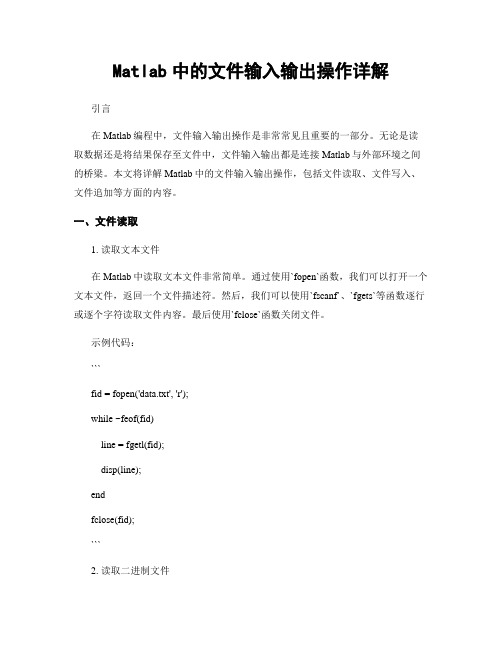
Matlab中的文件输入输出操作详解引言在Matlab编程中,文件输入输出操作是非常常见且重要的一部分。
无论是读取数据还是将结果保存至文件中,文件输入输出都是连接Matlab与外部环境之间的桥梁。
本文将详解Matlab中的文件输入输出操作,包括文件读取、文件写入、文件追加等方面的内容。
一、文件读取1. 读取文本文件在Matlab中读取文本文件非常简单。
通过使用`fopen`函数,我们可以打开一个文本文件,返回一个文件描述符。
然后,我们可以使用`fscanf`、`fgets`等函数逐行或逐个字符读取文件内容。
最后使用`fclose`函数关闭文件。
示例代码:```fid = fopen('data.txt', 'r');while ~feof(fid)line = fgetl(fid);disp(line);endfclose(fid);```2. 读取二进制文件与读取文本文件类似,读取二进制文件也需要使用`fopen`函数打开文件。
不同之处在于,我们使用`fread`函数以指定的格式读取文件内容。
同样,读取完毕后使用`fclose`函数关闭文件。
示例代码:```fid = fopen('data.bin', 'rb');data = fread(fid, 'double');fclose(fid);disp(data);```二、文件写入1. 写入文本文件想要将数据写入文本文件,我们可以通过`fopen`函数打开一个新的文件,并使用`fprintf`函数将数据进行格式化输出。
最后使用`fclose`函数关闭文件。
示例代码:```fid = fopen('result.txt', 'w');fprintf(fid, '%s\n', 'Hello, World!');fclose(fid);```2. 写入二进制文件与写入文本文件类似,写入二进制文件也需要使用`fopen`函数打开一个新的文件。
matlab中的输出函数

在 MATLAB 中,有许多输出函数用于显示和记录计算结果。
以下是几个常用的输出函数:
1.disp:用于在命令窗口中显示文本或变量值。
例如,disp('Hello,
world!')将输出“Hello, world!”到命令窗口。
2.fprintf:用于将格式化的数据写入到文件中或命令窗口中。
例如,
fprintf('The value of pi is: %f\n', pi)将输出“The value of pi is:
3.141593”到命令窗口。
3.varargout:用于从函数中返回多个输出值,并将其存储在可变数量的输出
参数中。
4.pause:用于暂停程序执行,并在命令窗口中显示消息或变量的值。
5.disp('请输入一个数字:'):用于显示提示消息,并等待用户输入。
用户输入
的值将被存储在变量中,以便后续使用。
这些函数只是 MATLAB 中输出函数的一部分,还有许多其他函数可用于不同目的的输出操作。
MATLAB的数据导入与导出

不在当前目录,系统将会在其他路径进行 搜索。 • FID = FOPEN(FILENAME,PERMISSION) FID 称为文件标识符,如果错误,返回-1
MATLAB的文件操作
• • • • • •
• •
'r' 'w' 'a' 'r+' 'w+' read write (create if necessary) append (create if necessary) read and write (do not create) truncate or create for read and
available and need not be • opened. They are FID=1 (standard output) and FID=2 (standard error). • FID, MESSAGE] = FOPEN(FILENAME,PERMISSION) • returns a system dependent error message if the open is not successful.
write
'a+' read and append (create if necessary) 'W' write without automatic flushing 'A' append without automatic flushing
MATLAB的文件操作
• Two file identifiers are automatically
Matlab数据的导入与导出(共39张)

调用格式:
[fid, message] = fopen(filename, permission) [filename, permission] = fopen(fid)
permission 'rt' 'wt' 'at' 'r+t' 'w+t' 'a+t' 'At'
'Wt'
说明 以只读方式打开文件。这是默认情况 以写入方式打开文件,若文件不存在,则创建新文件并打开。原文件内容会被清除 以写入方式打开文件或创建新文件。在原文件内容后续写新内容 以同时支持读、写方式打开文件 以同时支持读、写方式打开文件或创建新文件。原文件内容会被清除 以同时支持读、写方式打开文件或创建新文件。在原文件内容后续写新内容 以续写方式打开文件或创建新文件。写入过程中不自动刷新文件内容,适合于对磁带 介质文件的操作 以写入方式打开文件或创建新文件,原文件内容会被清除。写入过程中不自动刷新文 件内容,适合于对磁带介质文件的操作
>> x = dlmread('examp02_09.txt')
……
202222//11/1/188
第13页,共39页。
© 谢中华, 天津科技大学数学系.
4. 调用(diàoyòng)textread函数读取数据
调用格式: [A,B,C,…] = textread('filename','format') [A,B,C,…] = textread('filename','format',N) […] = textread(…,'param','value',…)
matlab数据传输

fprintf(fid,'%f\n',a');
fclose(fid); 注:对于高维矩阵,用dlmwrite构造的纯文本文件, Lingo软件不识别;为了Lingo软件识别,纯文本文件必 须用fprintf构造,而且数据之间的分割符为“\n”。
三、matlab数据文件
1.可以将工作空间中的变量用菜单save保存
例2使用dlmwrite命令把矩阵b保存到纯文本文件data3txtdlmwritedata3txtb例3生成服从标准正态分布随机数的矩阵然后用fprintf命令保存到纯文本文件data4txt
Matlab外部数据的传输
一 、excel数据的传输来自1.直接导入在文件菜单中选择 file/import data, 按照提示进行操作至结束。(book1.xls)
例1 把纯文本文件data2.txt加载到工作空间。
a=load('data2.txt'); 或 a=textread('data2.txt'); 例2使用dlmwrite命令把矩阵b保存到纯文本文件data3.txt。 dlmwrite('data3.txt',b)
例3生成服从标准正态分布随机数的矩阵,然后用 fprintf命令保存到纯文本文件data4.txt。 fid=fopen('data4.txt','w'); a=normrnd(0,1,100,200);
>> xlswrite('book3', a, 'shumo', 'E1') 将矩阵a写入book3.xls的shumo工作簿,从E1 开始写入。
>>D
matlab数据导入和导出

1. Xlsread读入数据[a3, h_lukou] = xlsread('ex1.xls','sheet3'); %指定工作表中数据,表头和字符数据存入h_lukou [a, h_lukou] = xlsread('2011B-data.xls', 'lukou'); %指定工作表中数据,表头和字符数据存入h_lukou [a, h_lukou] = xlsread('2011B-data.xls', 'A2:C3'); %读取指定区域的数据[g = xlsread('2011B-data.xls', 'A2:C300') %读取指定区域的数据2.文本数据1)a=textread('b-lukou.txt'); %这种读取的信息自动分隔,可带格式读整个文件,例见B2011_fig.m2)textscanfr = fopen('b-lukou.txt ', 'r'); txt数据空格分隔g1 = textscan(fr, '%d %d %d %f \n'); %读一行中指定格式的内容,指针移到未读处g1 = textscan(fr, '%d %d %d %f \n',N); %同一格式重复读N次,(包括P87例2.10好像不执行)fr = fopen('ex2.txt ', 'r'); txt数据’,’分隔g1 = textscan(fr, '%d %d %d %f \n','delimiter',',');textscan更适合读入大文件;textscan可以从文件的任何位置开始读入,而textread 只能从文件开头开始读入;textscan也可以从上一次textscan结束的位置开始读入,而textread不能;textscan只返回一个数组,而textread要返回多个数组;textscan提供更多转换读入数据的选择;textscan提供给用户更多的配置参数。
matlab中的数据导入和导出

matlab中的数据导入和导出Matlab提供了从磁盘文件或剪贴簿转载数据至工作区(数据导入)和将工作区变量存入磁盘文件(数据导出)的多种途径。
最简单的办法是使用界面导入向导,打开文件菜单中的导入数据而后按提示操作。
Matlab支持的主要数据文件类型和对应函数如下:导入文本文件文本文件需要具备统一的行列模式,使用分隔符作为数据项间隔,这些分隔符包括空格、逗号、tab、分号或其它。
数据文件可能附带标题行和行列头标签。
数值数据对于数值数据可以直接使用load函数装载,例如my_data.txt中数据如下:1 2 3 4 56 7 8 9 10命令A = load('my_data.txt')装载该文本文件数据。
如果数值数据使用其它分隔符,可以使用dlmread读入,假设my_data.txt中数据如下:7.2;8.5;6.2;6.65.4;9.2;8.1;7.2命令A = dlmread('my_data.txt', ';')读入该数据。
包含行列标签的数值数据例如:Grade1 Grade2 Grade378.8 55.9 45.999.5 66.8 78.089.5 77.0 56.7fid = fopen('grades.dat', 'r');grades = textscan(fid, '%f %f %f', 3, 'headerlines', 1);fclose(fid);包含字符和数值的混合数据使用textread函数读入。
导出文本文件save函数A = [ 1 2 3 4 ; 5 6 7 8 ];save my_data.out A –ASCIIdlmwrite函数dlmwrite('my_data.out',A, ';')MS-Excel电子表格文件xlsinfo获得文件信息使用命令[type, sheets] = xlsfinfo(filename)返回文件类型type和工作表信息。
matlab中输出的用法

matlab中输出的用法在 MATLAB 中,有多种方法可以输出结果。
下面我将介绍几种常用的输出方法。
1. 使用 disp() 函数:这是 MATLAB 中最常用的方法之一,可用于显示变量、向量、矩阵等。
它会在命令窗口中直接输出内容,如下所示:```matlabx = 10;disp(x); % 输出变量 x 的值```结果将显示为:```10```2. 使用 fprintf() 函数:这个函数可用于格式化输出,在命令窗口中以自定义的方式显示结果。
以下是一个示例:```matlabname = 'John';age = 25;fprintf('My name is %s and I am %d years old.\n', name, age);```上述代码将输出:My name is John and I am 25 years old.```3. 将结果赋值给变量:你可以将需要输出的结果赋值给一个变量,然后MATLAB 会自动将其显示在命令窗口中。
例如:```matlabresult = x + y; % 将两个变量相加,并将结果赋值给 resultresult % 输出 result 变量的值```结果将直接显示在命令窗口中。
4. 使用 disp()、fprintf() 或 sprintf() 函数结合循环输出结果:如果你需要在循环中多次输出结果,可以将 disp()、fprintf() 或 sprintf() 函数与循环结合使用。
这样可以逐个显示或格式化输出迭代结果。
```matlabfor i = 1:5disp(i); % 逐个输出迭代结果end```结果将依次显示为:```1345```希望这些方法可以帮助你在 MATLAB 中正确使用输出功能。
记得适当选择适合你输出需求的方法,使你的代码清晰易读。
matlab导出曲线数据的函数

在MATLAB中,导出曲线数据是一个常见的需求。
通常,我们需要将所得到的曲线数据保存到外部文件中,以便进行进一步的分析和处理。
在MATLAB中,有多种方法可以实现曲线数据的导出,包括使用内置函数、自定义函数以及第三方工具包等。
在本文中,我们将就MATLAB中导出曲线数据的函数进行全面评估,并探讨不同方法的优缺点,以及个人观点和理解。
1. 使用内置函数MATLAB提供了许多内置函数,可以帮助我们轻松地导出曲线数据。
其中最常用的函数是`dlmwrite`和`writematrix`。
这两个函数都可以将数值矩阵写入到文本文件中,非常方便且简单。
我们可以使用如下代码将曲线数据保存到一个名为`data.txt`的文本文件中:```matlabx = 1:10;y = sin(x);data = [x' y'];dlmwrite('data.txt', data, 'delimiter', '\t');```使用内置函数的优点是操作简单,代码量少,适用于快速导出小规模的曲线数据。
然而,这种方法也存在一些局限性,例如无法自定义输出格式、无法导出带有文本信息的数据等。
2. 自定义函数除了使用内置函数外,我们还可以编写自定义函数来实现曲线数据的导出。
通过编写自定义函数,我们可以更加灵活地控制导出的格式、内容以及文件命名等方面。
我们可以编写一个名为`exportData`的函数来实现曲线数据的导出:```matlabfunction exportData(filename, x, y)fid = fopen(filename, 'w');fprintf(fid, 'x\ty\n');for i=1:length(x)fprintf(fid, '%f\t%f\n', x(i), y(i));endfclose(fid);end```使用自定义函数的优点是可以完全按照需求进行定制,可以处理更加复杂的数据导出任务。
- 1、下载文档前请自行甄别文档内容的完整性,平台不提供额外的编辑、内容补充、找答案等附加服务。
- 2、"仅部分预览"的文档,不可在线预览部分如存在完整性等问题,可反馈申请退款(可完整预览的文档不适用该条件!)。
- 3、如文档侵犯您的权益,请联系客服反馈,我们会尽快为您处理(人工客服工作时间:9:00-18:30)。
matlab导出数据(fprintf,dlmwrite,xlswrite)
1.用fprintf 函数写数据到txt,xls
Example:
x = 0:.1:1;
y = [x; exp(x)];
fid = fopen('exp.txt', 'w');
fprintf(fid, '%6.2f %12.8f\n', y);
fclose(fid)
tip:执行上述代码执行,肯定不会换行的,换行的问题试一下下面的代码
x = 0:.1:1;
y = [x; exp(x)];
fid = fopen('exp.txt', 'wt');
fprintf(fid, '%6.2f %12.8f\n', y);
fclose(fid);
x = 1;
fid = fopen('exp.txt', 'w');
fprintf(fid, '%d', x);
fclose(fid);
这次就没有问题了,我们要注意fopne的参数wt 而不是 w,这是matlab的在线帮助的东东
fid = fopen(filename, permission_tmode) on Windows systems, opens the file in text
mode instead of binary mode (the default). The permission_tmode argument consists
of any of the specifiers shown in the Permission Specifiers table above, followed
by the letter t, for example 'rt' or 'wt+. On UNIX®systems, text and binary mode
are the same. (UNIX is a registered trademark of The
Open Group in the United States and other countries).
就是有两种读取模式binary or text. When choosing the binary model,No characters are
given special treatment. 所以我们选择要注明text模式。
2. dlmwrite :将一个矩阵写到由分隔符分割的文件中。
在保存整数到文件时使用save存为ascii文件时,常常是文件里都是实型格式的数据(有小数点,和后面很多的0,看着很不方便)。
于是要保存此类数据时,我们可以使用此dlmwrite命令。
使用方法:
dlmwrite('filename', M)
使用默认分隔符“,”将矩阵M写入文本文件filename中;
dlmwrite('filename', M, 'D')
使用分隔符D分割数据,“\t”表示tab分割,“,”为默认分割符;dlmwrite('filename', M, 'D', R, C)
从矩阵M的第R行、第C列开始,作为要写矩阵块的左上角,将数据用D分割写入文件。
其他用法有:
dlmwrite('filename', M, 'attrib1', value1, 'attrib2', value2, ...) dlmwrite('filename', M, '-append')
dlmwrite('filename', M, '-append', attribute-value list)
例如:
a = [1 2 3; 4 5 6; 7 8 9];
dlmwrite('test.txt', a);
则test.txt中的内容为:
1,2,3
4,5,6
7,8,9
而使用save
a = [1 2 3; 4 5 6; 7 8 9];
save 'tst.txt' a -ascii;文本文件里的内容为:
1.0000000e+000
2.0000000e+000
3.0000000e+000
4.0000000e+000
5.0000000e+000
6.0000000e+000
7.0000000e+000 8.0000000e+000 9.0000000e+000
3.xlswrite 写入excel
4.fprintf和dlmwrite区别
MATLAB在图像处理中的应用,实际是对图像矩阵的操做运算,MATLAB 在图像处理中的常用的命令有:
imread(): 从图像文件夹中读取图像的函数;
imwrite(): 输出图像的函数;
imshow(), image(): 图像显示于屏幕的函数;
imcrop(): 对图像进行裁剪的函数;;
imresize(): 实现对图像的插值缩放的函数;
imrotate(): 用实现对图像的旋转。
im2double(),double(): 将图像数组转化为double类型;
im2uint8(),uint8(): 将图像数组转化为uint8类型;
im2uint16(),uint16(): 将图像数组转化为uint16类型;
关于上述的命令使用方法可以参考一些MATLAB方面的书籍或者用MATLAB自带的帮助(help or doc)命令.
如我想知道dwt2()命令的使用方法可以执行下面的命令
>> help dwt2 或 >>doc dwt2
系统就会告诉你它的使用要求和方法,如果系统说找不到对应的帮助文件,那就可能是你装的MATLAB里面没有这个命令,那很可能这个命令就不能使用.
在图像数组的输出到文件的操作上,我发现fprintf比dlmwrite明显快很多,但这两个输出的数据格式有些差别,见下面操作:
>> a=[1 2 3;4 5 6;7 8 9]
a =
1 2 3
4 5 6
7 8 9
>>fid = fopen('exp.txt','w');
fprintf(fid,'%2.0f\n',a);
fclose(fid);
>> type exp.txt
1
4
7
2
5
8
3
6
9
fprintf输出是一列一列的从左到右输出。
>> dlmwrite('eg2.dat',a,'\n');
>> type eg2.dat
1
2
3
4
5
6
7
8
9
dlmwrite输出是一行一行的从上到下输出。
下面是一个比较简单的图像处理程序:
clear;%清除当前工作区所有变量
data=imread('E:\2D前处理\eg1.bmp');%从图像文件夹中读取图像eg1.bmp
data=double(data);%将图像数组data转化为double类型
[x,y]=size(data);%求数组大小,x是data数组有多少行,y是data数组有多少列
data1=imresize(data,[x,y*2/1.732]);%实现对图像的左右插值放大2/1.732倍
[x,y]=size(data1);%%求放大后图像数组大小
fid = fopen('E:\2D前处理\Particle\test.dat', 'wt');%打开图像数组的将要输出到文件fprintf(fid, '%2.0f\t%2.0f\n', x, y);%输出x,y值
fprintf(fid, '%2.0f\n', data1);%输出图像数组数据
fclose(fid);%关闭文件指针。
